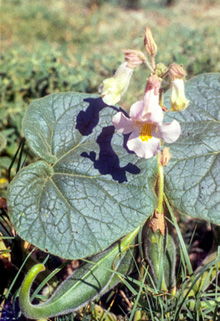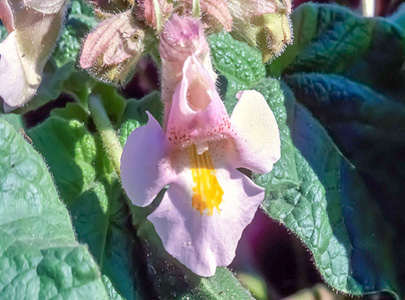In response to a recent question, this World of Weeds article is focused on devil’s claw (Proboscidea louisianica), also known as unicorn-plant or ram’s horns (Figure 1). This annual plant is notable for its large leaves, aromatic foliage, and distinctive seed pods. It is a member of the Pedaliaceae family, which also includes the sesame plant (the source for sesame seeds and oil).

Figure 1. Devil's claw. Photo by Jeanne Falk Jones, K-State Research and Extension.
Ecology
Devil’s claw is a native of the southwestern United States and Mexico. It currently can be found across the continental U. S. and into southern Canada, and has been introduced into Europe, Asia, South Africa, and Australia. Devil’s claw is considered a declared pest (noxious weed) in some regions of Australia. Native Americans utilized the seeds for food, and the dried fruits in basketry and for making dye. Fresh fruits of devil’s claw have also been pickled and eaten, similar to okra. In Oklahoma, devil’s claw at 4,200 and 11,000 plants per acre reduced cotton lint yields 46 and 96%, respectively. The succulent nature of the plant and the hard, wiry seed pods may interfere with harvest or tillage operations. The dried fruits of the plant can also cause physical injury to livestock, especially around the nose and mouth.
Identification
Devil’s claw is an annual broadleaf species that reproduces by seeds. It grows up to 4 feet tall, producing numerous erect or spreading fleshy branches. The large leaves are heart- or kidney-shaped, up to 7 inches long, and as wide as 8 inches (Figure 2). A long stalk (petiole) connects the leaves to the stems. Both the stems and leaves are covered with glands that produce a sticky, foul-smelling sap. Flowers are large (up to 2 inches), pale pink to white, and funnel-shaped. Yellow lines and reddish spots typically adorn the throats of the flowers (Figure 3). Large, curved seed pods up to 4 inches long are produced and covered with a fleshy outer rind. At maturity, the rind sloughs off, revealing a woody endocarp containing the seeds.

Figure 2. The flowers, large leaves, and immature seed pod of devil’s claw. Photo courtesy New Mexico State University.

Figure 3. Close-up of devil’s claw flower showing the red spots on the upper petals and yellow lines on the lower petals. Photo courtesy New Mexico State University.
Research from Oklahoma indicated that devil’s claw plants can produce more than 8,500 seeds per plant when grown in the absence of competition. At maturity, the endocarp splits from the tip into two sharp, curved horns or claws (Figure 4-top). The dried fruits catch on the legs of animals or on machinery, which aids in the dispersal of the seeds. Seeds are relatively large, black, and rough-coated (Figure 4-bottom).


Figure 4. Mature seed pod (top) and seeds of devil’s claw (bottom). Photos by Jeanne Falk Jones and Patrick Geier, K-State Research and Extension.
Management
Depending on the crop being grown, several herbicide families have proven effective at controlling devil’s claw. Group 2 herbicides such as imazamox (Beyond, others), prosulfuron (Peak), and halosulfuron (Permit) have shown good to excellent postemergence devil’s claw control. Imazamox may be especially useful in sunflowers where broadleaf weed control options are limited. However, a Clearfield sunflower hybrid must be planted in order to apply imazamox. The synthetic auxin herbicides (Group 4), such as 2,4-D, also provide good control where labeled. Glufosinate (Group 10) and glyphosate (Group 9) are effective when used in crops resistant to those herbicides. The PPO-inhibiting herbicides (Group 14) flumioxazin (Valor, others) have some preemergence activity on devil’s claw, while lactofen (Cobra) provides excellent postemergence control in soybean. Premixtures that include a Group 15 (S-metolachlor, acetochlor, others) along with a Group 27 herbicide (mesotrione, others) provide good to excellent devil’s claw control when applied preemergence or early postemergence. Examples of these premixes include Acuron, Lumax EZ, Harness Max, and Storen.
More information about devil’s claw control can be found at:
The use of trade names is for clarity to readers and does not imply endorsement of a particular product, nor does exclusion imply non-approval. Always consult the herbicide label for the most current use requirements.
References
Riffle, M. S. et al. 1990. Soil-water relations and interference between devil 's-claw (Proboscidea louisianica) and cotton (Gossypium hirsutum).
Stubbendieck, J. et al. 1994. Weeds of Nebraska and the Great Plains.
Patrick Geier, Weed Scientist, Garden City
pgeier@ksu.edu
Sarah Lancaster, Extension Weed Management Specialist, Manhattan
slancaster@ksu.edu
Jeanne Falk Jones, Multi-County Agronomist
jfalkjones@ksu.edu
Jeremie Kouame, Weed Scientist, Agricultural Research Center – Hays
jkouame@ksu.edu